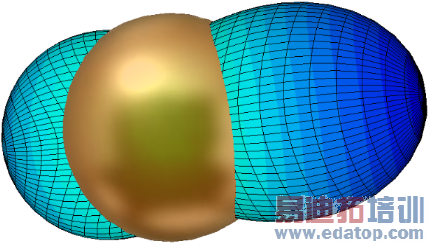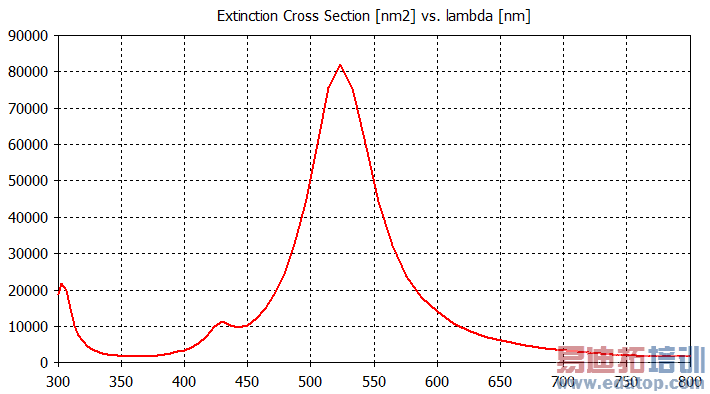- 易迪拓培训,专注于微波、射频、天线设计工程师的培养
Drude Material Optical Scatterer - CST2013 MWS Examples

General Description
This example calculates the "Extinction Cross Section" of a metal coated silica sphere at optical frequencies.
Structure Generation
First, general settings concerning the background material, the absorbing boundary condition (open add space) and the units (nm) are defined. The actual structure is created drawing two spheres and using a Boolean insert. The silica material is defined as simple "normal" material with an epsilon value of 2.08. The metal material properties are modelled by using "Drude dispersion model". The corresponding Drude parameters can be extracted by using the macro Home: Macros 
 Materials
Materials  Create Drude Parameters for Optical Applications.
Create Drude Parameters for Optical Applications.
Solver Setup
For accurate simulations, it is required to refine the mesh for the Drude material. In this model a mesh resolution of 1 nm is used by selecting the metal sphere and using local mesh properties. A plane wave is used to excite the structure. Because of the resonant behavior at certain frequencies (plasmon generation) an accuracy setting of -50 dB is used.
Post Processing
The broadband scattering response is extracted by using a broadband farfield monitor. This monitor already automatically writes the total radar cross section (Total RCS) as well as the total absorption cross section (Total ACS) into the 1D Results folder. The sum of these values is derived as the extinction cross section by usage of a "Mix 1D" result template. For optical applications, it is common to plot any result against the wavelength, so again a "Mix 1D" result template is used to change the X axes from frequency to wavelength:

CST微波工作室培训课程套装,专家讲解,视频教学,帮助您快速学习掌握CST设计应用
上一篇: Circulator - CST2013 MWS Examples
下一篇: Dielectric Lens - CST2013 MWS Examples
 最全面、最专业的CST微波工作室视频培训课程,可以帮助您从零开始,全面系统学习CST的设计应用【More..】
最全面、最专业的CST微波工作室视频培训课程,可以帮助您从零开始,全面系统学习CST的设计应用【More..】
频道总排行
- Rectangular Waveguide Tutorial
- FSS: Simulation of Resonator
- CST2013 MWS Examples: Thermal C
- Dipole Antenna Array - CST201
- CST MWS Examples - CST2013 M
- Microstrip Radial Stub - CST2
- Dielectric Resonator Antenna -
- Interdigital Capacitor - CST20
- CST2013 MWS Examples: Biological
- Lossy Loaded Waveguide - CST2
